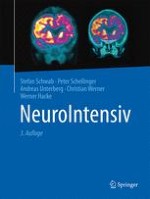2015 | Neurologische Diagnostik | OriginalPaper | Buchkapitel
5. Neurophysiologische Diagnostik
verfasst von : Helmut Buchner, Prof. Dr., Rene Gobbelé, Prof. Dr., Peter Ringleb, Prof. Dr., Georg Karpel-Massler, Dr., Andreas Unterberg, Prof. Dr., Oliver Sakowitz, Prof. Dr., Christopher Beynon, Dr., Prof. Dr. Thorsten Steiner, Christoph Terborg, PD Dr., Emanuela Keller, Prof. Dr., Raimund Helbok, PD Dr., Christian Dohmen, Dr., Martin Seule, Dr.
Erschienen in: NeuroIntensiv
Verlag: Springer Berlin Heidelberg











